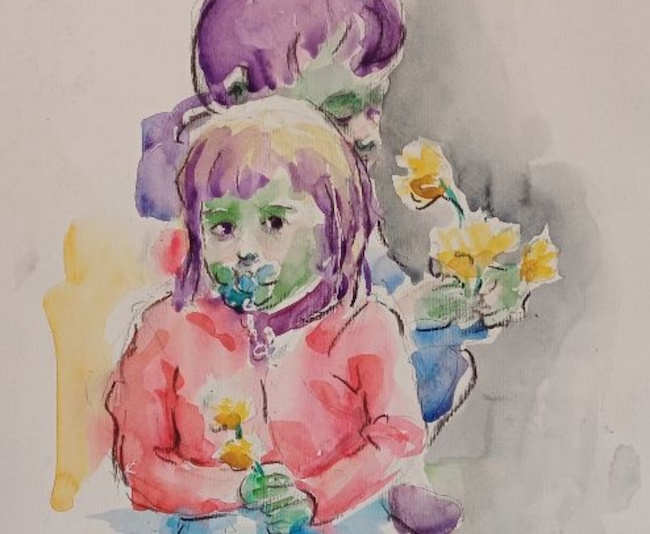La caratteristica più evidente dell’arte contemporanea è quella di mescolare, fondere, tecniche e stili pittorici in origine distanti e ben separati, per essere adattati al sentire, all’inclinazione pittorica dell’autore di un’opera senza doversi attenere ai confini delineati appartenenti ai movimenti dei secoli precedenti; il dare forma a un’emozione, un punto di vista, un approccio nei confronti dell’esistenza non si può conformare a una regola prestabilita bensì emergere in maniera spontanea e naturale attraverso un linguaggio personale e spesso risultato di sperimentazione. La protagonista di oggi sceglie l’acquarello per imprimere nell’osservatore la propria sensazione di leggerezza, di levità nell’osservare la semplicità dell’esistenza che spesso ha solo bisogno di essere guardata da una sfaccettatura diversa per apparire più piacevole di quanto previsto.
Nel corso della storia dell’arte si è delineata l’esigenza di trovare una tecnica di semplice stesura, che potesse essere base esecutiva per opere maggiori, l’acquarello è pertanto divenuto una sorta di complemento al disegno con cui i grandi maestri preparavano gli studi delle tele più celebri; tuttavia intorno al Seicento cominciò ad assumere una rilevanza diversa, un’identità propria grazie alla sua velocità di asciugatura che consentiva ai grandi paesaggisti di terminare l’opera prima della fine della giornata di lavoro all’aria aperta. In particolar modo fu nel Settecento con l’affermarsi del Romanticismo inglese che ebbe in maestri di grande talento come William Turner e John Robert Cozens, un’importante rappresentanza di artisti che scelsero proprio l’acquarello per descrivere e immortalare alcuni dei loro affascinanti paesaggi in grado di travolgere le emozioni del fruitore. Qualche decennio dopo, la tecnica innovativa dell’Impressionismo nell’esecuzione del dipinto en plein air in cui fu protagonista la pittura a olio non escluse però l’utilizzo dell’acquarello da parte di alcuni tra i maggiori nomi del movimento come Claude Monet ed Edgar Degas. Anche i grandi maestri dell’Espressionismo, come Cézanne e Gauguin, dell’Astrattismo come Paul Klee e del Cubismo con il suo sommo rappresentante Pablo Picasso, utilizzarono ampiamente questa tecnica sperimentandola e inserendola nella loro ricerca pittorica e affiancandola ai dipinti in cui utilizzavano l’olio. Non solo, anche negli Stati Uniti Edward Hopper, magistrale esponente del Realismo Americano, realizzò molte delle sue opere più celebri come Alta strada, Coast Guard Cove e Jo Sketching at Good Harbor Beach proprio utilizzando il colore ad acqua. Dunque da un’esigenza prevalentemente pratica e legata essenzialmente ai paesaggisti e agli artisti in viaggio che dunque avevano bisogno di una rapidità di asciugatura per poter proseguire il loro cammino esplorativo, come gli artisti del Gran Tour, questa tecnica ha conquistato nel tempo maggiore spazio in virtù della sua adattabilità e versatilità ma soprattutto per la sua immediatezza esecutiva; la capacità e l’orientamento alla sperimentazione del Novecento ha permesso agli artisti aderenti ai vari movimenti di rompere schemi e regole e conquistare nuovi modi di intendere l’espressione artistica e dunque ogni tecnica poteva diventare interprete delle linee guida delle correnti che si avvicendavano e a volte si osteggiavano.
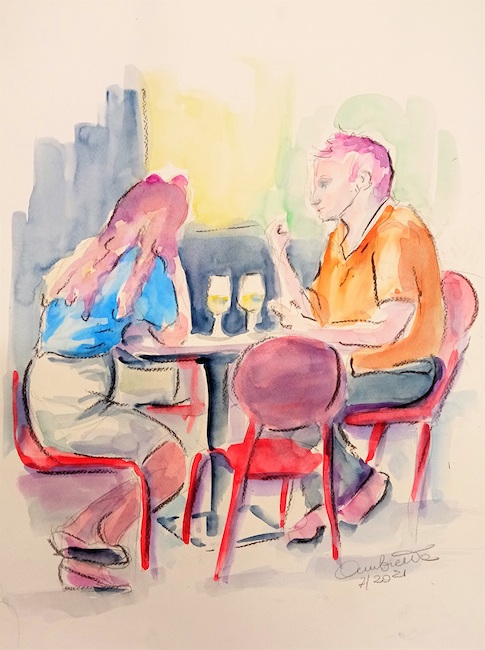
L’artista di origini lombarda ma torinese d’adozione Ambretta Rossi utilizza la materia leggera dell’acquarello per adattarla a un stile personale, riconoscibile per la sua tendenza all’impalpabilità unita alla piacevolezza delle sue opere in cui unisce la naturalezza di frammenti di vita colti attraverso una profonda capacità di osservazione del mondo circostante, da cui prende la positività, la bellezza, l’unicità di ogni istante che riempie in quel piccolo frangente, l’esistenza dei suoi protagonisti.
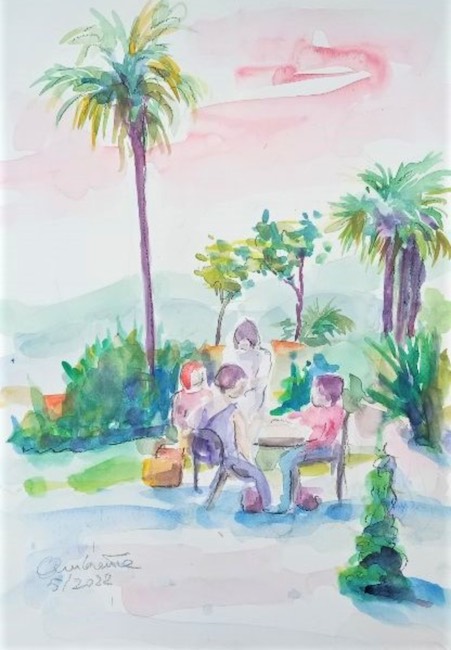
Lo stile pittorico è l’Espressionismo perché è solo attraverso di esso che può associare i colori alle emozioni che vengono suscitate nella fase in cui il suo sguardo si posa sulla realtà circostante e diviene interprete delle impalpabili energie che circondano e si propagano dai gesti semplici e spontanei dei suoi personaggi; il disegno, il tratto grafico che precede la pittura e definisce le immagini immortalate, è essenziale per dare consistenza e definizione a tutto ciò che poi, attraverso il colore, viene sfumato quasi come se l’artista si trovasse davanti a un sogno, a una morbida visione.
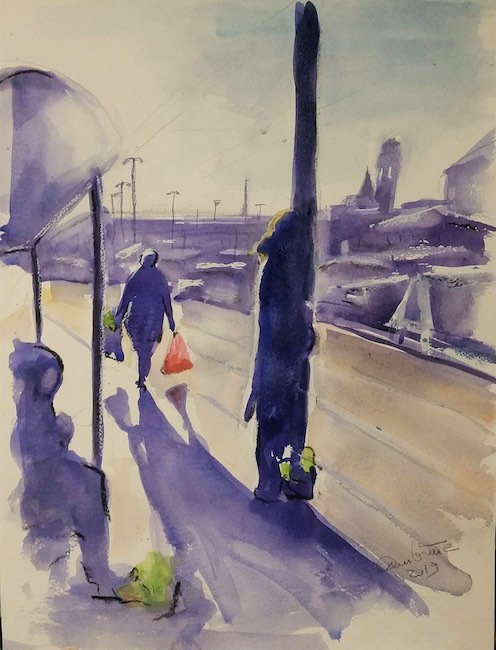
Le atmosfere appaiono dunque come sospese, tanto quanto la gamma cromatica contribuisce a sottolineare la pienezza che si nasconde dietro gesti semplici, quotidiani eppure in grado di rendere la vita più appagante, più lieve e meno concentrata sulle problematiche; emerge pertanto in modo chiaro il modo in cui Ambretta Rossi percepisce l’esistenza, una somma di istanti apparentemente irrilevanti che se sommati insieme costituiscono invece la vera essenza, tutto ciò che contribuisce a riempire gli spazi tra un grande avvenimento e l’altro del percorso di ciascuno.
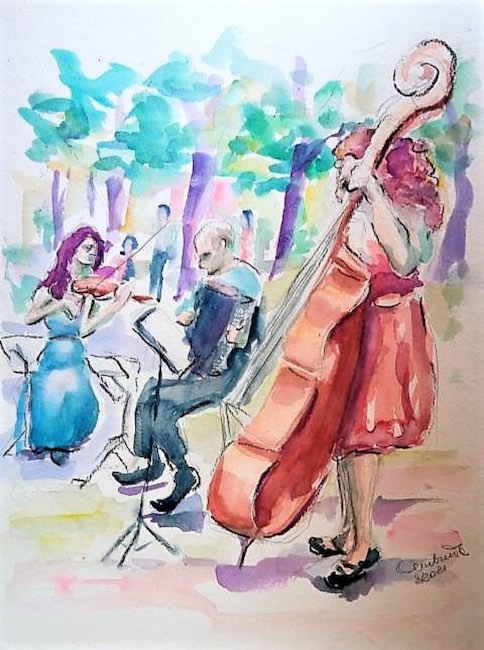
In Concertino nel parco i musicisti sembrano avvolti dalla magia impalpabile della musica classica, quel susseguirsi di note che non possono essere ignorate dai passanti e che contribuiscono a rendere indimenticabile una semplice passeggiata; lo sfondo è rarefatto tanto quanto appena accennati sono i dettagli degli alberi che circondano la scena, come se l’attenzione dell’osservatore dovesse concentrarsi sull’esecuzione dei suonatori, su quel loro essere nel momento presente. Le tonalità sono sfumate e al tempo stesso affini allo stato d’animo dei protagonisti e di conseguenza a metà tra sogno e realtà, tra reale e irreale perché in fondo i loro gesti appartengono alla sfera emozionale e dunque il colore deve associarsi a essa.
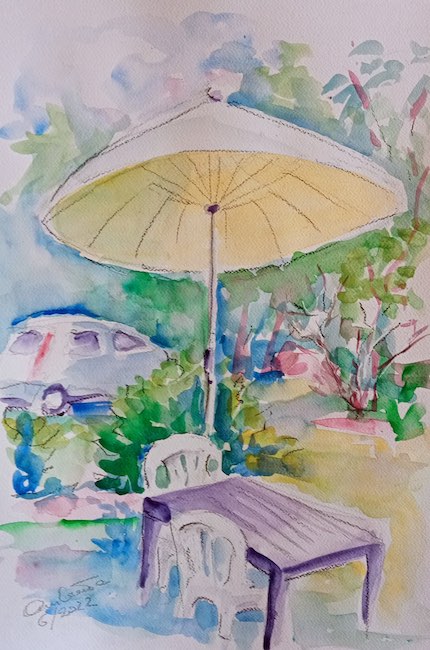
In Automobile in giradino l’artista si avvicina al tema del paesaggio anche se inserisce un elemento moderno, l’auto, che la colloca pienamente nel suo tempo malgrado lo sguardo romantico e morbido che rivolge a tutto ciò che entra a far parte anche solo per un istante del suo vissuto; anche in questo caso l’effetto visivo è quello della cartolina estiva, della memoria di un momento di riposo, di distacco dalla frenesia della quotidianità che fa la differenza tra il lasciarsi prendere dal vortice degli accadimenti e la saggezza di sedersi e prendere tutto con maggiore calma, che in fondo il modo migliore di vivere. La leggerezza e la piacevolezza dello sguardo dell’artista si percepisce dalla quasi trasparenza del disegno e del colore molto diluito, proprio per infondere una sensazione di evanescenza, di delicatezza, un invito a seguirla nel suo percorso di distacco dalle pesanti zavorre costituite dalle convinzioni limitanti e dall’abitudine a seguire il flusso degli eventi piuttosto che a prendere in mano la propria vita e far sì che prenda una direzione diversa.
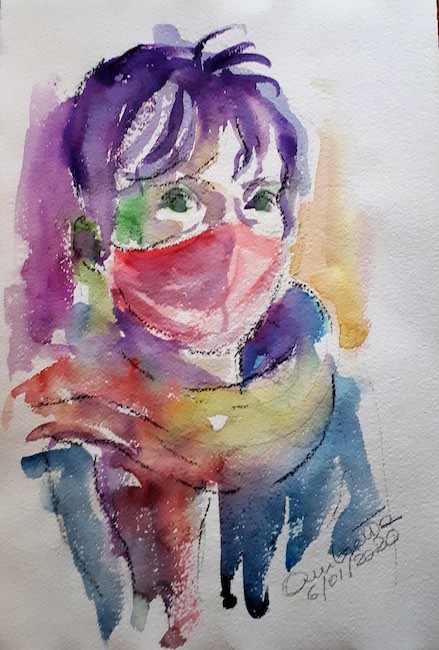
Anche il recente evento pandemico viene rappresentato da Ambretta Rossi con la medesima capacità di accettazione, non passivamente, questo no, piuttosto con la consapevolezza che costituisce solo un frammento di un’intera vita e come tale va osservato e vissuto; il suo Autoritratto con mascherina la ritrae con sguardo al tempo stesso costernato per ciò che l’umanità ha dovuto attraversare ma anche sereno in virtù della sua fiducia verso il dopo trasmessa dagli occhi che spiccano sul suo volto proprio grazie alla presenza della mascherina, occhi che guardano diretti verso l’osservatore dell’opera quasi a volerlo rassicurare. Le tonalità in questo caso sono più intense, per catturare il momento presente, forte, reale, innegabile, eppure legate ai colori dell’anima con il viola dei capelli, con l’azzurro del sogno, con il rosso della forza. Le persone sono protagoniste delle sue opere, tanto quanto la natura, pur lasciandone emergere quel tranquillo mondo emotivo in grado di manifestarsi quando sono sovrappensiero, quando non cercano né aspettano nulla bensì semplicemente assaporano il frammento di esistenza immortalato dall’artista.
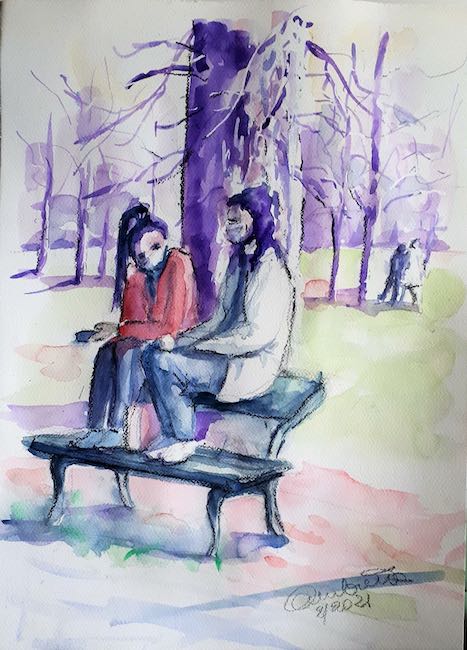
La scelta dell’acquarello è stata per Ambretta Rossi una richiesta della sua interiorità, fin dall’inizio del suo percorso artistico frequenta infatti corsi tenuti dai maggiori maestri piemontesi prima e internazionali poi, specializzati in questa tecnica. Fa parte di diversi gruppi artistici e ha al suo attivo la partecipazione a mostre collettive ed estemporanee, a concorsi artistici sul territorio nazionale e internazionale – Barcellona, Parigi, Budapest – ottenendo premi e riconoscimenti, tra i più importanti il terzo posto alla Mostra Concorso Internazionale Bologna 2020. Ma il suo percorso artistico conta anche cinque importanti mostre personali durante le quali ha mostrato al suo pubblico di appassionati e collezionisti il suo stile alla costante ricerca della semplicità.
AMBRETTA ROSSI-CONTATTI
Email: ambrettarossi@libero.it
Facebook: https://www.facebook.com/ambrettarossi
Instagram: https://www.instagram.com/ambrettarossi/
The beautiful side of life in Ambretta Rossi’s nuanced watercolour works, the result of a delicate and impalpable Expressionism
The most evident characteristic of contemporary art is that of mixing, blending, techniques and pictorial styles that were originally distant and well separated, to be adapted to the feeling, to the pictorial inclination of the author of an artwork without having to adhere to the delineated boundaries belonging to the movements of previous centuries; the shaping of an emotion, a point of view, an approach to existence cannot conform to a pre-established rule but rather emerge spontaneously and naturally through a personal language that is often the result of experimentation. Today’s protagonist chooses watercolour to impress upon the observer her own sensation of lightness, of levity in observing the simplicity of existence, which often only needs to be looked at from a different facet to appear more pleasant than expected.
Throughout the history of art there has been a need to find a technique of simple drafting that could be the basis of execution for major artworks, watercolour has therefore become a sort of complement of drawing with which the great masters prepared their studies of the most famous canvases; however, around the seventeenth century it began to take on a different relevance, an identity of its own thanks to its speed of drying that allowed the great landscape painters to finish their artwork before the end of the day’s work in the open air. In particular, it was in the 18th century with the rise of English Romanticism, which had in such talented masters as William Turner and John Robert Cozens, an important representation of artists who chose watercolour to describe and immortalise some of their fascinating landscapes capable of overwhelming the viewer’s emotions. A few decades later, Impressionism’s innovative technique of painting en plein air in which oil painting was the protagonist did not, however, exclude the use of watercolour by some of the movement’s greatest names such as Claude Monet and Edgar Degas. The great masters of Expressionism, such as Cézanne and Gauguin, of Abstractionism such as Paul Klee and of Cubism with its supreme representative Pablo Picasso, also made extensive use of this technique, experimenting with it and incorporating it into their pictorial research, alongside paintings in which they used oil.
Not only that, even in the United States, Edward Hopper, a masterful exponent of American Realism, produced many of his most famous works such as High Street, Coast Guard Cove and Jo Sketching at Good Harbor Beach precisely using watercolour. Thus, from a predominantly practical need and essentially linked to landscape painters and travelling artists who therefore needed a quick drying time in order to be able to continue their exploratory journey, such as the artists of the Grand Tour, this technique gained more space over time by virtue of its adaptability and versatility but above all for his executive immediacy; the ability and orientation towards experimentation in the 20th century allowed artists adhering to the various movements to break schemes and rules and conquer new ways of intending artistic expression, and thus each technique could become an interpreter of the guidelines of the currents that alternated and sometimes opposed each other. The artist, originally from Lombardy but Turinese by adoption, Ambretta Rossi, uses the light material of watercolour to adapt it to a personal style, recognisable by her tendency towards impalpability combined with the pleasantness of her artworks in which she combines the naturalness of fragments of life captured through a profound ability to observe the world around her, from which she takes the positivity, the beauty, the uniqueness of each instant that fills the existence of her protagonists in that small juncture. Her painting style is Expressionism because it is only through it that she can associate the colours with the emotions that are aroused in the phase in which her gaze rests on the surrounding reality and becomes the interpreter of the impalpable energies that surround and propagate from the simple and spontaneous gestures of her characters; the drawing, the graphic stroke that precedes the painting and defines the immortalised images, is essential to give consistency and definition to everything that is then, through colour, blurred almost as if the artist were in front of a dream, a soft vision. The atmospheres therefore appear as if suspended, as much as the chromatic range helps to emphasise the fullness that is hidden behind simple, everyday gestures, yet capable of making life more fulfilling, lighter and less focused on problems; the way in which Ambretta Rossi perceives existence therefore emerges clearly, a sum of apparently irrelevant instants that when added together constitute the true essence, everything that contributes to filling the spaces between one great event and another in everyone’s journey.
In Concertino nel parco the musicians seem to be enveloped in the impalpable magic of classical music, that succession of notes that cannot be ignored by passers-by and that contribute to make a simple stroll unforgettable; the background is as rarefied as the details of the trees surrounding the scene are barely noticeable, as if the observer’s attention were to focus on the players’ performance, on their being in the present moment. The tones are nuanced and at the same time akin to the mood of the protagonists and consequently somewhere between dream and reality, between real and unreal, because after all their gestures belong to the emotional sphere and therefore the colour must associate with it. In Automobile in the Roadside, the artist approaches the theme of the landscape even though she inserts a modern element, the car, which places her fully in her time despite the soft, romantic gaze she turns to everything that becomes part of her experience, even if only for a moment; again, the visual effect is that of a summer postcard, of the memory of a moment of rest, of detachment from the frenzy of everyday life that makes the difference between letting oneself get caught up in the whirlwind of events and the wisdom of sitting down and taking everything more calmly, which after all is the best way to live.
The lightness and pleasantness of the artist’s gaze can be perceived in the almost transparency of the drawing and the very diluted colour, precisely to instil a feeling of evanescence, of delicacy, an invitation to follow her on her path of detachment from the heavy ballast of limiting beliefs and the habit of following the flow of events rather than taking charge of her own life and making it take a different direction. Even the recent pandemic event is portrayed by Ambretta Rossi with the same capacity for acceptance, not passively, not at all, but rather with the awareness that it constitutes only a fragment of an entire life and should be observed and experienced as such; her Autoritratto con mascherina (Self-portrait with a mask) portrays her with a gaze that is at once dismayed at what humanity has had to go through but also serene in virtue of her trust in the future conveyed by the eyes that stand out on her face precisely because of the presence of the mask, eyes that look directly at the observer of the artwork almost as if to reassure him.
The tones in this case are more intense, to capture the present moment, strong, real, undeniable, yet linked to the colours of the soul with the purple of hair, the blue of dreams, the red of strength. People are the protagonists of her artworks, just as much as nature, while allowing that quiet emotional world to emerge when they are overthinking, when they are not looking for or expecting anything but simply savouring the fragment of existence immortalised by the artist. For Ambretta Rossi, the choice of watercolour was a request from her inner self. Indeed, from the very beginning of her artistic career, she attended courses held by Piedmontese masters and then international ones specialising in this technique. She is a member of several artistic groups and has participated in group and extemporary exhibitions and artistic competitions in Italy and abroad – Barcelona, Paris, Budapest – obtaining prizes and awards, the most important of which was third place at the International Exhibition Competition Bologna 2020. But her artistic career also counts five important solo exhibitions during which she has shown her style in constant search of simplicity to her public of enthusiasts and collectors.


